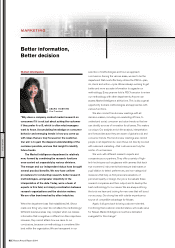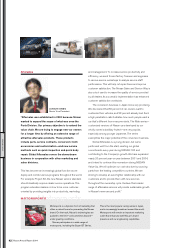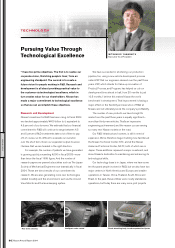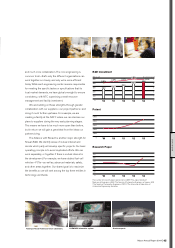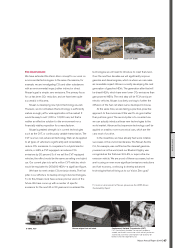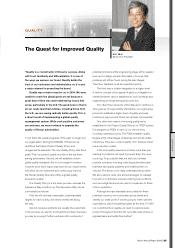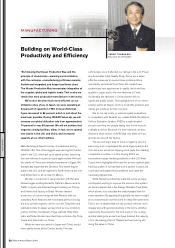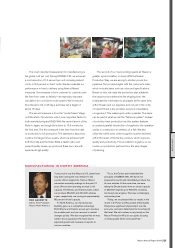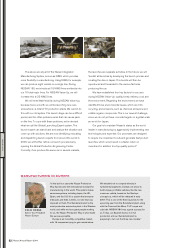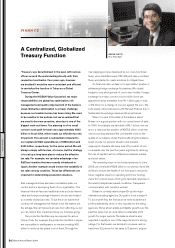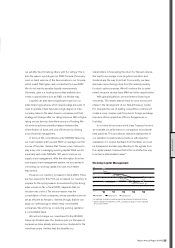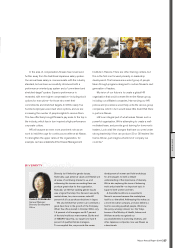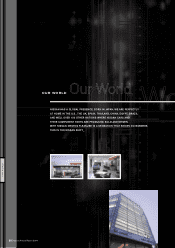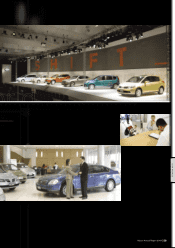Nissan 2005 Annual Report Download - page 51
Download and view the complete annual report
Please find page 51 of the 2005 Nissan annual report below. You can navigate through the pages in the report by either clicking on the pages listed below, or by using the keyword search tool below to find specific information within the annual report.
Nissan Annual Report 2004 49
potential problems at the engineering stage, at the supplier
level, and in design models. We realize, of course, that
problems will still be found during the later stages.
Therefore, feedback must be submitted quickly.
The third way is to take integration to a higher level.
A vehicle consists of thousands of parts, so integration is
needed between various departments, such as design and
engineering and engineering and production.
The other three elements of the Way are to reinforce a
strong sense of responsibility, standardize our engineering
process to establish a higher level of quality, and seek
continuous improvement. These are all basic but essential.
One other new means of ensuring quality we’ve
established is the Project Quality Director or “PQD” system.
I’ve assigned six PQDs to each of our vehicle lines,
including overseas projects. The PQDs establish quality
targets at the initial stages of development and at certain
milestones. They also conduct quality clinic drives and test
pre-production models.
In the end, quality assurance involves more than just
reacting to problems; we need to prevent them from ever
occurring. To accomplish that, we test out countless
possible scenarios, including collecting automotive parts
that have had quality problems and installing them on
vehicles. This allows us to really understand the problem.
We also examine used cars at several stages to evaluate
how well our parts have endured under typical conditions
such as sunlight and acid rain, and in comparison to those
of the competition.
Although we have standards and criteria for these
potential concerns, we must assess actual trends and
identify our weak points if we are going to meet customer
expectations, which are getting higher all the time. To fulfill
our commitments on quality, we need to examine every
product throughout its entire life cycle. We must do this on
a global basis, and better than before.”
QUALITY
“Quality is a crucial factor in Nissan’s success. Along
with trust, familiarity and differentiation, it is one of
the ways we express our brand. Quality builds the
trust of our customers and stakeholders, so it is also
a major element in promoting the brand.
Quality was a major issue for us in 2004. We were
unable to reach the global goals we set because a
great deal of time was spent addressing issues that
arose, particularly in the U.S. The good news is that in
all our newly launched vehicles, including those from
the U.S., we are seeing radically better quality. This is
a direct result of implementing a global quality
management system. While such positive outcomes
are welcome, we must continue to upgrade the
quality of Nissan automobiles.
To be frank, the quality programs of the past no longer suit
our organization. During the NISSAN 180 period, we
redefined the Nissan Product Quality Policy and
reorganized its elements. The new Quality Policy sets three
goals. First, our product quality must be in the top three
among automakers. Second, we will establish uniform
global quality standards; this is not a single-fix solution,
however, since each region may have its own requirements.
And third, we will implement and continuously improve
the Nissan Quality Assurance Way, a global quality
assurance system.
The Quality Policy is a top-down process, whereas the
Assurance Way is bottom up. The Assurance Way can be
summarized as follows:
First, we will set clear, reasonable, understandable
targets for each activity, and review milestones along
the way.
Second, because problems are usually discovered late
in the process, we want to front-load the problem-discovery
process by moving it further upstream. We must predict
The Quest for Improved Quality
EIJI IMAI
Senior Vice President
OUR WORK



